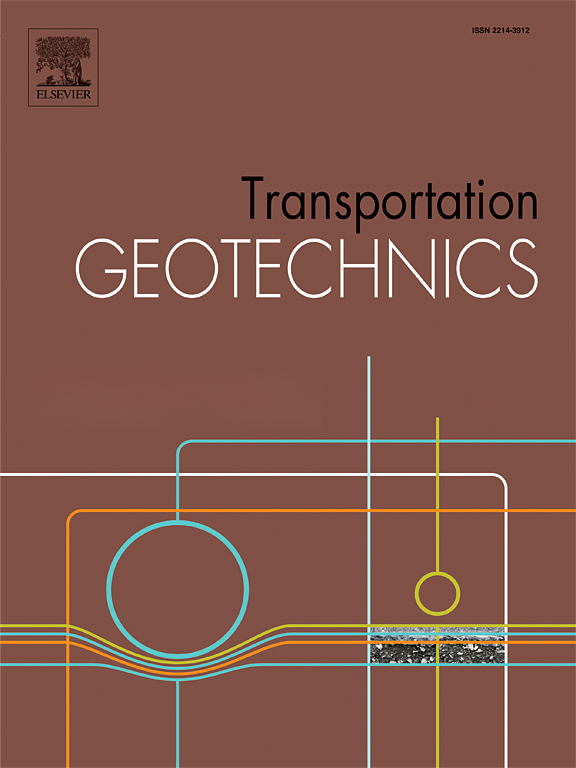Strength deterioration and predictive modeling of coarse-grained soil under penetrating erosion effects
IF 4.9
2区 工程技术
Q1 ENGINEERING, CIVIL
引用次数: 0
Abstract
This investigation aims to explore the strength deterioration characteristics of coarse-grained soils (CGSs) under penetrating erosion. Unconsolidated undrained (UU) triaxial tests were conducted on untreated specimens and those subjected to four amplitudes of penetrating erosion force (p0), to examine the impact of penetrating erosion on the shear performance of CGSs with varying mass ratios of mudstone fines (η). Furthermore, a strength prediction model, KM-C(η, p0), was developed based on the Mohr-Coulomb (M−C) strength criterion, incorporating both η and p0 as influencing factors. The results indicate that untreated specimens predominantly exhibit bulging deformation upon failure, whereas treated specimens can be divided into distinct bulging and non-bulging zones, with significant transverse cracks emerging in the transition region between these zones. Moreover, treated CGS specimens demonstrate notable strain-softening behavior, as the deviator stress peak [(σ1–σ3)max] decreases linearly with increasing penetrating erosion force p0 under the same confining pressure (σ3). Furthermore, minor variations in confining pressure have little effect on the strength weakening induced by penetrating erosion, and at low confining pressures, both untreated and treated specimens conform to the M−C failure criterion. Additionally, there exists a critical fine content threshold ηcritical; when the fine content is below this threshold, increasing it enhances the stability of the CGS skeleton and its resistance to seepage erosion. Conversely, when the fines content exceeds ηcritical, the filling effect of the fines weakens the stability of the soil skeleton, thereby reducing its resistance to penetrating erosion. In this investigation, ηcritical is determined to be 9.15%. Lastly, the predictive model developed in this study accurately captures the influence of η and p0 on the strength of CGSs, with the relative error between the measured and predicted strength values ranging from 1.1% to 14.9%.
穿透侵蚀作用下粗粒土强度劣化及预测模型
本研究旨在探讨穿透侵蚀作用下粗粒土的强度劣化特征。为了研究不同泥岩细粒质量比(η)下,未固结不排水(UU)三轴试验对未经处理的试样和经受4种穿透侵蚀力(p0)的试样的剪切性能的影响。基于Mohr-Coulomb (M−C)强度准则,建立了以η和p0为影响因素的强度预测模型KM-C(η, p0)。结果表明:未处理试样破坏时主要表现为胀形变形,而处理试样可分为明显的胀形区和非胀形区,在两个区域之间的过渡区域出现明显的横向裂纹。在相同围压(σ3)条件下,随着侵穿侵蚀力p0的增大,偏离应力峰值[(σ1 ~ σ3)max]呈线性减小;此外,较小的围压变化对穿透侵蚀引起的强度减弱影响不大,在低围压下,未处理和处理的试样均符合M−C破坏准则。存在临界细含量阈值η临界值;当细粒含量低于该阈值时,增加细粒含量可增强CGS骨架的稳定性和抗渗流侵蚀能力。反之,当细粒含量超过η临界值时,细粒的填充作用削弱了土壤骨架的稳定性,从而降低了其抗渗透侵蚀的能力。在本次调查中,η临界值确定为9.15%。最后,本文建立的预测模型准确地反映了η和p0对CGSs强度的影响,实测值与预测值之间的相对误差在1.1% ~ 14.9%之间。
本文章由计算机程序翻译,如有差异,请以英文原文为准。
求助全文
约1分钟内获得全文
求助全文
来源期刊

Transportation Geotechnics
Social Sciences-Transportation
CiteScore
8.10
自引率
11.30%
发文量
194
审稿时长
51 days
期刊介绍:
Transportation Geotechnics is a journal dedicated to publishing high-quality, theoretical, and applied papers that cover all facets of geotechnics for transportation infrastructure such as roads, highways, railways, underground railways, airfields, and waterways. The journal places a special emphasis on case studies that present original work relevant to the sustainable construction of transportation infrastructure. The scope of topics it addresses includes the geotechnical properties of geomaterials for sustainable and rational design and construction, the behavior of compacted and stabilized geomaterials, the use of geosynthetics and reinforcement in constructed layers and interlayers, ground improvement and slope stability for transportation infrastructures, compaction technology and management, maintenance technology, the impact of climate, embankments for highways and high-speed trains, transition zones, dredging, underwater geotechnics for infrastructure purposes, and the modeling of multi-layered structures and supporting ground under dynamic and repeated loads.
 求助内容:
求助内容: 应助结果提醒方式:
应助结果提醒方式:


